Last week I introduced some design ideas for Low Impact Development (LID). One of these ideas is what I am calling LID layering – a decentralized approach in which the designer incorporates multiple layers of LID elements throughout the drainage path. The land side component of Metro’s M. James Gleason Boat Ramp site is a good example of this technique. While nothing more than a big parking lot, design features throughout the project combine to create a system that treats and infiltrates stormwater runoff onsite in all but the biggest storms.
Completed in 2013, Gleason is the result of a master planning effort that reaches back to 1999. Oregon’s most used boat launch provides urban access to the Columbia River for users of all types, and conveniently hosts extensive parking for both trailered and non-trailered vehicles, restrooms and a river patrol office. Master planning and design was completed by KPFF Consulting Engineers with landscape architecture by Mayer Reed and plumbing and mechanical design by MFIA. Engineering features of the site include a debris deflection wall and both traditional and bio-engineered slope stabilization measures.
The tree canopy is the first possible point of contact between falling rain and the Gleason site. The site’s main purpose is providing parking for people using the river and admittedly landscaping was a secondary consideration in the design process, but there are trees and over the coming years they will grow to cover portions of the parking lot. The truth is, though, that most of the rain at Gleason will land on pavement.
Pavement type is Gleason’s second LID layer. While heavy loads, high levels of use and cost considerations dictated that most of the site be paved in asphalt, permeable pavers were used on the single car parking spaces, which will see much less traffic. Rain on these areas directly infiltrates, reducing the amount and delaying the concentration of runoff from paved areas. The change in material also adds a nice aesthetic. As with canopy cover, permeable pavement is a small piece of the storm drain system, but the cumulative impact of small measures early in the drainage path can be as important as larger downstream measures when developing a layered LID system.
Perhaps the most significant piece of the drainage approach at Gleason is the fact that, except in isolated areas, all of the pavement is sloped to sheet flow to stormwater facilities. This avoids concentrating flows – both at the surface and in piped systems – and led to more flexibility in designing the site’s stormwater planters. This is not to mention the fact that a flat, smooth parking lot with few or no drainage structures makes a better driving surface in both wet and dry conditions than one littered with dips, valleys, warps and catch basins.
Flush curbs were used on most parts of the Gleason site, providing both edge restraint for the pavement and walls for the adjacent stormwater planters. As opposed to collecting water in catch basins, shedding it from the surface into the planters delays flow concentration and allows the system to be much shallower. Wheels stops were added where the curb line also needed to serve as protection for parking vehicles, and slotted curbs where planters run adjacent to traffic lanes.
At this point, it is worth noting an often overlooked LID layer. As stormwater flows across paved surfaces, it picks up a large amount of the sediment that cars track onto the pavement. Much of this sediment can be quickly filtered out by directing water through a short conveyance swale or across a small filter strip before it enters a larger stormwater facility, resulting in better water quality and less maintenance. These features were incorporated into Gleason’s design where possible, but – as can be the case – space and geometry constraints precluded their use in some instances.
Runoff entering Gleason’s stormwater planters infiltrates fairly quickly, thanks to the site’s well drained, sandy soils. Because of this, it was possible to over design some planters by basing the planter depth on what the surrounding curb walls could support and not on what was required to meet the minimum standards. Designing to the “maximum extent feasible” like this is a core LID principle. In many cases it is possible to exceed minimum requirements without adding cost to the project. Where planter bottom elevations varied, steel weirs were installed to ensure that different levels filled together.
Some larger storms will exceed Gleason’s onsite stormwater management capacity. In these cases, water will overflow through raised catch basin structures and outfall into the river. Each planter also has an overland overflow route to the river that would be used if its basin were to clog. This route could also be used in extreme storms, but most of the site is below the flood plain and could be underwater in those cases.
Gleason’s storm drainage system is a good example of using LID on a pavement and vehicle centric project and counters the view of LID as a “greener” design option that only works on heavily landscaped or naturalized projects. In truth, while they work better in some cases than in others, LID concepts can and should be used on every project. These concepts don’t as much represent a new group of options, as they signify a shift in what is considered best practice in stormwater engineering design.
While there is a significant environmental benefit from this shift, there are economic and functional benefits, too. LID measures saved Metro money on the Gleason project by reducing the amount of pipe and number of drainage structures that needed to be installed. These same measures resulted in a simple grading and storm drain design that makes the site more friendly to drivers.
With simultaneous benefits to the function, economics and sustainability of civil design projects, it is clear that LID is worth the focus and advocacy it is currently being given.

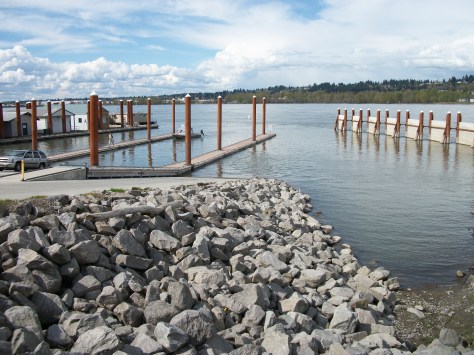
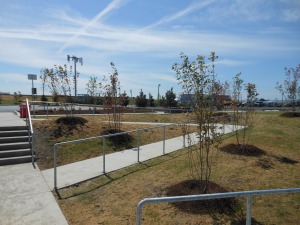
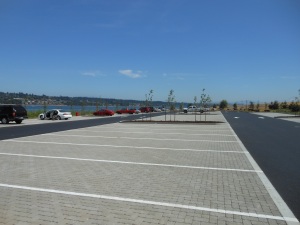
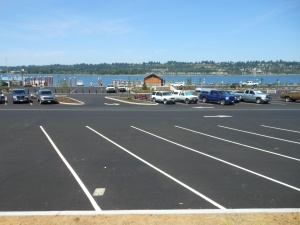
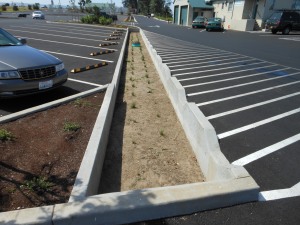

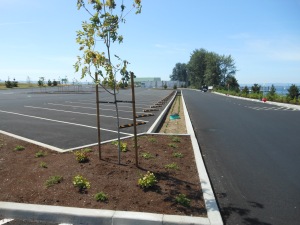

Excellent writing Peter!
I’m guessing there also be long term cost savings from the reduced stormwater rate charges. Nice job!
Thanks – this is a great summary about one case study that also incorporates some of the most important principles and benefits of using an integrated approach to site design. The “layering” term is very useful language that describes the idea of multiple treatment practices or BMPs in an elegant and concise way, and because you note that thinking this way should begin with the tree canopy and work down and out from there, it helps to clearly convey this concept in the context of how water actually flows.